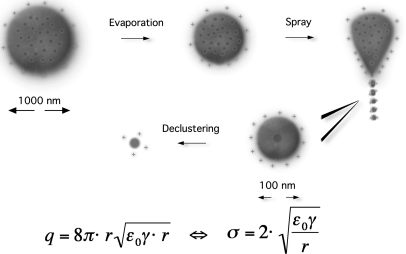Fig. 2.
The charge residue process. A highly charged droplet shrinks by solvent evaporation until the field strength at the location with the highest surface curvature is so large that a Taylor Cone forms. From the tip of the Taylor Cone, other highly charged smaller droplets are emitted. This process can repeat itself until droplets are formed that contain only one analyte molecule. This molecule is released as an ion by solvent evaporation and declustering. The equation describes the maximum charge a droplet can carry before the Coulomb repulsion overcomes the surface tension. Locally, it is the condition for the formation of a Taylor Cone. q, droplet charge at the Rayleigh instability limit; r, droplet radius; ε0, electric permittivity of the surrounding medium; γ, surface tension; σ, surface charge density.

